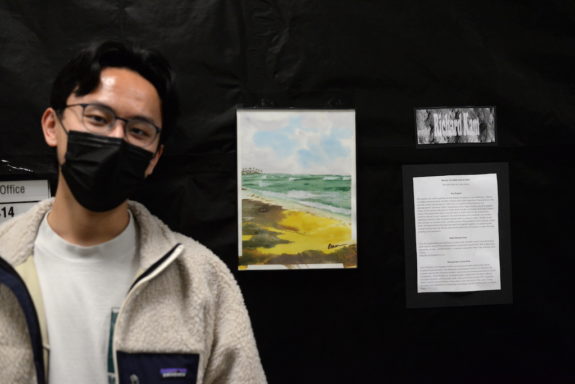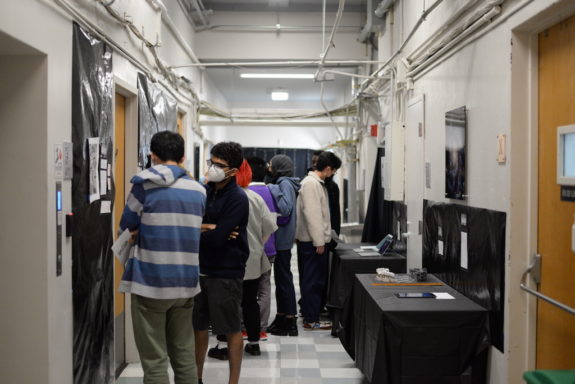On Friday, Staff Writer Charles Bonkowsky attended CU Blueshift’s annual Arts & Astro showcase in the Astronomy Library at Pupin Hall.
“From paintings to poetry, from shows to symphonies, astronomy and the arts have always been in constant conversation,” begins the Arts & Astro program, the motto of the artists and astronomers who gathered to show off their work. Paintings, drawings, and collages were hung on the walls, accompanied by the the background music of someone trying to figure out how many astronomy-related songs there are for solo acoustic guitar (a nonzero number—I heard Space Oddity—but not the largest genre out there).

Several different mediums were visible on both sides of the gallery, in art pieces drawing on a range of inspirations. A comic about an interplanetary long-distance romance, which the artist, Mary Clare Greenless, a senior at Barnard, explained was made using the intaglio printmaking technique: the lines of the drawing are etched into copper plates, filled with ink, and then printed onto the paper itself. A collage of midterms, rejection emails, and news clippings from Aiden Cloud’s first year at Columbia College.

Paintings of ocean waves, counterparts, the artist Richard Kam told me, to the waves which ripple across the surface of neutron stars. The actual physics are incredibly complicated, because the plasma layer of ions and electrons which form the surface of a neutron star don’t quite act like liquid oceans, but the same kind of tidal forces are operating on them nonetheless.


After we’d had our fill of wandering about the slightly-too-narrow Pupin hallways, the presentations began. First up was Ranger Liu, who worked on the NASA mission to Psyche as an artist—which, to be clear, sounds like the coolest job someone could have. Working (a) on a NASA mission, (b) about an asteroid that’s potentially the exposed core of a planet, (c) as an artist with basically free range… the dream. The reason they were presenting was that their projects were audiovisual: mechanically-created music mimicking the tools the Psyche probe would contain.
Several students then presented their research, their PowerPoints moderately plagued with technical issues. Julian Gerber spoke about his research searching for faint high-mass X-ray binary systems near the galactic center; Io Stelea about modeling the structure of the Milky Way, the Large Magellanic Cloud, and the Sagittarius Dwarf Galaxy; and Zoë Tremitiere demonstrated the OpenSpace simulation and data-vis software. All of the topics were fascinating, and, when I left the event, it seemed like the possibilities—artistic and astronomical—were endless.
Header image: Round Chess, picture via Charlie Bonkowsky
Gallery pictures via Charlie Bonkowsky


 0 Comments
0 Comments